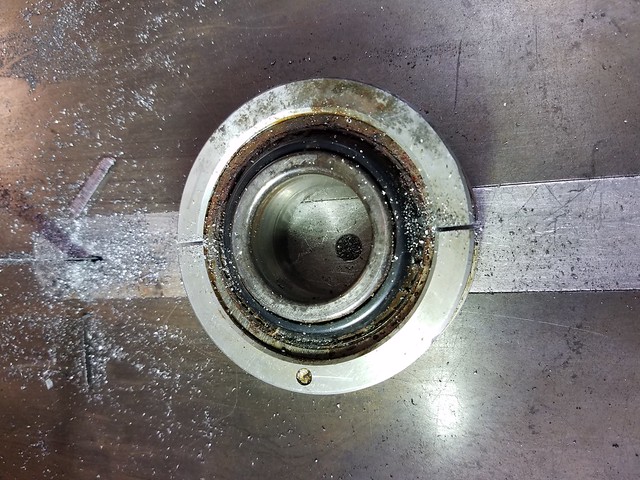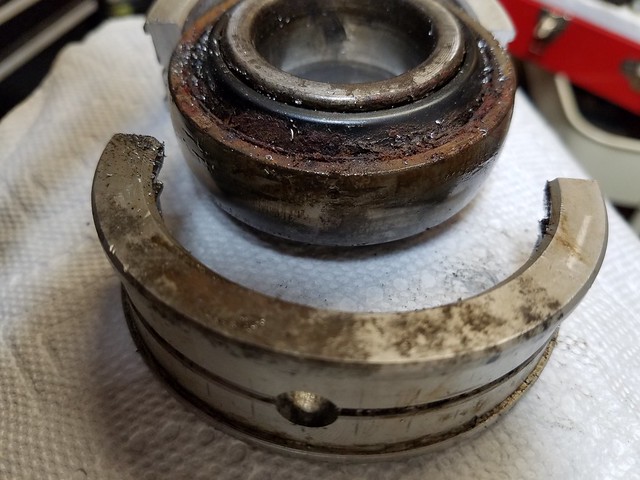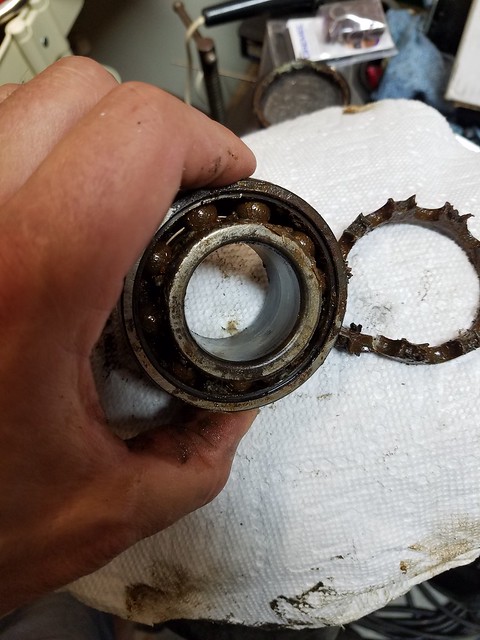Saline Marina
Petty Officer 2nd Class
- Joined
- Sep 9, 2014
- Messages
- 162
I was interested in taking a deeper look at the gimbal bearing I took out of my Four Winns 170 4.3GL MY2000 "charcoal paint" model, SX-M drive on it.
The bearing was noisy this spring and I did take it to the lake for about 3 minutes to determine what I heard in the driveway was indeed an issue on the water.
One issue is that I had never found a suitable grease fitting coupler for the gimbal bearing fitting on the transom shield. Its super tight on a 170 and the "slide-on-from-the-side" grease coupler won't work due to the fitting being in a shallow counterbore.
So it was off to the shop to create the tool, starting with standard Alemite coupler.

A little machining of a 0.465-32 thread and a 1/8NPT crossing internal thread....

....and the prototype is alive. It uses the top half of the Alemite coupler screwed together with my adapter.

Just made it! Whew

I changed the gimbal bearing, ordered a Sierra replacement so it was "greaseable". I gave it a couple of shots after installation but the grease seemed to all come out between the aluminum ring and the spherical outer race, instead of being pushed out between the inner anr outer races. So then my curiousity was awakened to see if it was actually greaseable.
Quick trip to the bandsaw to slice thru the aluminum outer ring.

So to answer my question, yes there's a tiny hole in the outer race that presumably goes thru.

And also one on the opposite side.

So I can see why the recommendation to run the engine and then pump the grease.
This is the inner of the aluminum outer ring, this approximates the inside of a sphere to allow the gimbal to rotate and align with the crankshaft.

I pried off the metal shields and the "organizer cage" and its a single row deep groove bearing. I had soaked some oil into the races previously just to see if the gritty feeling got better, and it never did, but some oil did seep down into the place where it could help.

You can see how crusty it was previously, hopefully don't have to go there anytime soon if I keep using the tool. I don't know if it helps anyone but it was interesting at least to me to get a little deeper understanding of the components used.

The bearing was noisy this spring and I did take it to the lake for about 3 minutes to determine what I heard in the driveway was indeed an issue on the water.
One issue is that I had never found a suitable grease fitting coupler for the gimbal bearing fitting on the transom shield. Its super tight on a 170 and the "slide-on-from-the-side" grease coupler won't work due to the fitting being in a shallow counterbore.
So it was off to the shop to create the tool, starting with standard Alemite coupler.

A little machining of a 0.465-32 thread and a 1/8NPT crossing internal thread....

....and the prototype is alive. It uses the top half of the Alemite coupler screwed together with my adapter.

Just made it! Whew

I changed the gimbal bearing, ordered a Sierra replacement so it was "greaseable". I gave it a couple of shots after installation but the grease seemed to all come out between the aluminum ring and the spherical outer race, instead of being pushed out between the inner anr outer races. So then my curiousity was awakened to see if it was actually greaseable.
Quick trip to the bandsaw to slice thru the aluminum outer ring.

So to answer my question, yes there's a tiny hole in the outer race that presumably goes thru.

And also one on the opposite side.

So I can see why the recommendation to run the engine and then pump the grease.
This is the inner of the aluminum outer ring, this approximates the inside of a sphere to allow the gimbal to rotate and align with the crankshaft.

I pried off the metal shields and the "organizer cage" and its a single row deep groove bearing. I had soaked some oil into the races previously just to see if the gritty feeling got better, and it never did, but some oil did seep down into the place where it could help.

You can see how crusty it was previously, hopefully don't have to go there anytime soon if I keep using the tool. I don't know if it helps anyone but it was interesting at least to me to get a little deeper understanding of the components used.




















